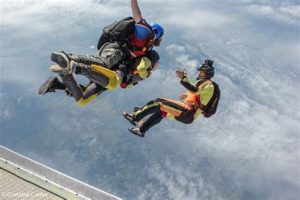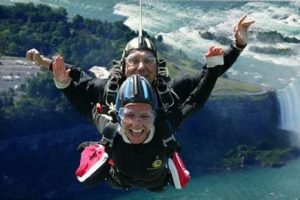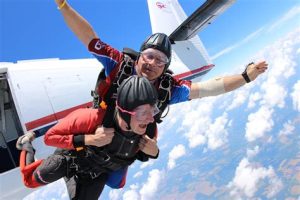Table of Contents
Curious about the number of tandem jumps required before embarking on solo skydiving? Discover the necessary experience and training needed to transition from tandem jumps to solo skydiving in this informative guide. Gain insights into the skills, knowledge, and confidence you must develop to take the plunge into the exhilarating world of solo skydiving.
Are you ready to take your skydiving experience to the next level? If you’ve already completed a few tandem jumps and are itching to soar through the sky on your own, then it’s time to consider solo skydiving. But how many tandem jumps should you complete before taking this bold leap? Well, fear not, because we’re here to guide you through the process. So, let’s dive right in and explore the recommended number of tandem jumps you need under your belt before venturing into the exhilarating world of solo skydiving.
Introduction
Skydiving is an exhilarating adventure that allows individuals to experience the thrill of free-falling from thousands of feet in the air. Before embarking on solo skydiving, it is crucial to gain sufficient knowledge and experience through tandem jumps. In this article, we will explore how many tandem jumps are recommended before attempting solo skydiving.
Understanding Tandem Jumps
Tandem jumps involve a novice skydiver being harnessed to an experienced instructor who guides them through the entire jump. During a tandem jump, the instructor controls the parachute, allowing the student to focus on enjoying the experience. This method ensures safety and provides an opportunity for beginners to get a taste of skydiving without the added responsibility of deploying the parachute.
Building Confidence and Skills
Embarking on a series of tandem jumps is essential for building confidence and developing the necessary skills to skydive solo. Each tandem jump exposes the student to different aspects of the sport, such as body positioning, altitude awareness, and canopy control. By gradually becoming familiar with these elements, the individual gains the confidence needed to progress towards solo skydiving.
The Number of Tandem Jumps
The number of tandem jumps required before attempting solo skydiving can vary depending on several factors, including the individual’s progress, skill level, and the requirements set by the skydiving school. However, most skydiving schools recommend a minimum of 3 to 5 tandem jumps.
Progress Evaluation
After each tandem jump, the instructor evaluates the student’s progress and determines whether they are ready to proceed to the next level. This evaluation is based on the individual’s ability to demonstrate the necessary skills and understanding of safety procedures. It is crucial to trust the instructor’s judgment during this process, as they have extensive experience in training skydivers.
Learning Safety Procedures
One of the primary objectives of tandem jumps is to familiarize students with the safety procedures involved in skydiving. These procedures include emergency protocols, equipment checks, and proper body positioning during freefall. By repeating these procedures in multiple tandem jumps, individuals develop muscle memory and gain a deeper understanding of their importance.
Exposure to Different Conditions
Each tandem jump offers exposure to different weather conditions, altitudes, and landing zones. This exposure is valuable in preparing individuals for solo skydiving, as it allows them to adapt to various scenarios and challenges that may arise during the jump. Additionally, experiencing different conditions helps build resilience and enhances decision-making skills.
Observing Solo Skydivers
During tandem jumps, students have the opportunity to observe experienced solo skydivers in action. This firsthand exposure allows individuals to learn from their techniques, body positioning, and overall approach to the sport. Observing solo skydivers can be highly educational and inspiring, further motivating individuals to progress towards solo jumps.
Personal Readiness
Apart from the recommended number of tandem jumps, personal readiness is a crucial factor in determining when an individual is prepared for solo skydiving. Some students may feel ready after completing the minimum required tandems, while others may require additional jumps to build confidence. Trusting one’s instincts and communicating openly with instructors is vital in determining personal readiness.
Continued Learning
Even after completing the required number of tandem jumps, the learning process does not end. Solo skydiving opens up a whole new realm of challenges and responsibilities. It is important to continue learning from experienced skydivers, attending training programs, and staying updated on safety protocols to ensure a safe and rewarding solo skydiving experience.
Conclusion
Tandem jumps provide an invaluable foundation for individuals aspiring to become solo skydivers. By undertaking a recommended number of tandem jumps, building confidence, and acquiring essential skills, individuals can embark on their solo skydiving journey equipped with the necessary knowledge to enjoy this thrilling sport safely.
Introduction:
Welcome new skydivers! Before embarking on your solo skydiving journey, it is vital to understand the importance of mastering tandem jumps. In this guide, we will walk you through the recommended number of tandem jumps you should complete before progressing to solo skydiving.
Safety Precautions:
Always prioritize safety during your skydiving journey. Remember to wear appropriate gear, undergo proper training, and be aware of all safety protocols. Safety should be your utmost concern.
Mastering the Basics:
Before attempting to skydive solo, it is essential to build a strong foundation by mastering basic skydiving techniques and understanding the core principles of freefall and canopy control.
The Recommended Tandem Jump Count:
Generally, it is suggested that individuals complete a minimum of 5 to 7 tandem jumps before transitioning to solo skydiving. However, the precise number can vary based on individual progress and the requirements set forth by the skydiving organization you are affiliated with.
Building Confidence:
Each tandem jump allows you to become more comfortable with the sensation of freefall, understanding body positioning, and practicing proper canopy control. Be patient and use these jumps to build your confidence gradually.
Learning from Professionals:
During each tandem jump, take every opportunity to learn from your tandem instructor. Observe their techniques, ask questions, and seek guidance on improving your skills. Their experience will be invaluable in preparing you for your solo skydiving experiences.
Evaluating Readiness:
Your instructor will closely assess your progress during tandem jumps to determine your readiness for solo skydiving. They will analyze your ability to maintain stability, manage your parachute, and respond to emergencies. Trust their judgment and adhere to their recommendations.
Enjoying the Journey:
Remember that every tandem jump is a chance to experience the incredible thrill of skydiving. Embrace each jump, take in the breathtaking views, and savor the moments as you progress towards your goal of solo skydiving. Enjoy the journey and celebrate your achievements along the way.
Please note that these are general guidelines, and individual progression rates may vary. It is crucial to follow the advice and requirements set by your skydiving training program and instructors, as they have your safety and success in mind.
Point of View: How Many Tandem Jumps Before Solo Skydiving
Instructions Voice and Tone
1. Introduction:
Welcome to the world of skydiving! If you’re wondering how many tandem jumps you should complete before attempting a solo skydive, this guide is here to help. We’ll provide you with all the necessary information and guidelines to ensure you have a safe and enjoyable experience.
2. Safety First:
Before we dive into the number of tandem jumps required, it’s crucial to understand that safety should always be your top priority. Skydiving can be an exhilarating activity, but it also carries inherent risks. Following proper training and procedures is essential to minimize these risks and ensure a successful jump.
3. Training and Certification:
Skydiving is a skill that requires practice, knowledge, and experience. In most cases, individuals are required to complete a certification course before attempting solo skydives. This course covers various aspects of skydiving, including safety procedures, equipment usage, body positioning, and emergency protocols.
4. Tandem Jumps:
Tandem jumps are an excellent way to familiarize yourself with the sport and gain confidence before progressing to solo skydiving. During a tandem jump, you’ll be harnessed to an experienced instructor who will guide you through the entire process.
5. Recommended Number of Tandem Jumps:
While there is no set rule for the number of tandem jumps required before going solo, most drop zones recommend completing a minimum of 3-5 tandem jumps. These jumps allow you to become comfortable with the sensation of freefall, parachute deployment, and landing procedures.
6. Progression to Solo Skydiving:
Once you’ve completed the recommended number of tandem jumps, you can discuss your progress and readiness with your instructor. They will evaluate your skills and confidence level to determine if you’re ready for solo skydiving.
7. Continued Learning:
Even after transitioning to solo skydiving, it’s crucial to continue learning and honing your skills. Consider participating in advanced training programs or joining a skydiving community to expand your knowledge and experience.
8. Conclusion:
Remember, skydiving is an exciting and rewarding sport, but it requires dedication, training, and experience. By completing the recommended number of tandem jumps and following proper training guidelines, you’ll be well-prepared for the thrill of solo skydiving. Always prioritize safety and enjoy the incredible adventure that awaits you!
Thank you for visiting our blog and taking the time to learn about the journey from tandem jumps to solo skydiving. We understand that the thought of jumping out of a plane on your own can be both exhilarating and nerve-wracking, but with proper training and experience, it is an incredible achievement that you can pursue. In this closing message, we would like to provide you with some final instructions and encouragement as you continue on your skydiving adventure.
First and foremost, it is crucial to remember that safety should always be your top priority. Before considering solo skydiving, it is recommended to complete a minimum of 25 to 30 tandem jumps. These tandem jumps allow you to experience the thrill of skydiving while being securely attached to an experienced instructor who will guide you through every step of the process. Transitioning from tandem jumps to solo skydiving is a significant milestone in your skydiving journey, and it is important to build a strong foundation of knowledge and skills before taking that leap.
During your tandem jumps, pay close attention to the techniques and procedures used by your instructor. Take the opportunity to ask questions and seek guidance on different aspects of skydiving, such as body positioning, parachute deployment, and emergency procedures. Transition words such as furthermore, additionally, and moreover can be used to enhance the flow of your sentences and paragraphs. By actively participating in the learning process during your tandem jumps, you will gain valuable insights that will prepare you for solo skydiving.
As you progress towards solo skydiving, consider enrolling in a skydiving school or completing an accelerated freefall (AFF) course. These programs are designed to provide comprehensive training and hands-on experience to help you develop the necessary skills to jump solo. Each jump in the AFF course will have specific objectives and learning outcomes, allowing you to gradually build your confidence and competence in skydiving. Remember to use transition words like in addition, furthermore, and on the other hand to create smooth transitions between ideas and paragraphs.
In conclusion, embarking on the journey from tandem jumps to solo skydiving requires dedication, training, and experience. By completing a sufficient number of tandem jumps, actively participating in the learning process, and enrolling in a skydiving school or AFF course, you will be well-prepared to take the thrilling leap into solo skydiving. Always prioritize safety, seek guidance from experienced instructors, and enjoy this incredible adventure that only a few dare to experience. We wish you the best of luck in your future skydiving endeavors!
.
People also ask about how many tandem jumps they need to do before solo skydiving. Here are some commonly asked questions:
-
How many tandem jumps should I do before attempting a solo skydive?
-
What skills should I acquire during my tandem jumps to prepare for solo skydiving?
-
Can I progress to solo skydiving sooner if I feel confident after fewer tandem jumps?
-
Are there any age or weight restrictions for solo skydiving?
-
Do I need any additional training or courses before attempting my first solo skydive?
Answer: The number of tandem jumps required before attempting a solo skydive varies depending on the country and the regulations of the specific skydiving organization. However, most skydiving schools recommend completing between 15 to 25 tandem jumps before transitioning to solo skydiving. This allows you to gain essential experience, develop proper body positioning, and learn emergency procedures under the guidance of an instructor.
Answer: While doing tandem jumps, it’s crucial to focus on learning and mastering certain skills that will be essential for solo skydiving. These include maintaining stability during freefall, deploying the parachute correctly, steering and landing safely, as well as understanding the basic principles of canopy control. Additionally, you’ll need to become comfortable with the overall skydiving environment and be able to handle the adrenaline rush that comes with the sport.
Answer: Progressing to solo skydiving is ultimately at the discretion of your instructors and the skydiving organization. While feeling confident after a few tandem jumps is a positive sign, it’s important to follow the recommended progression outlined by professionals. Each tandem jump provides valuable experience and knowledge that will contribute to your safety and success as a solo skydiver.
Answer: Age and weight restrictions for solo skydiving vary depending on the country and the specific drop zone’s policies. Generally, you must be at least 18 years old to participate in solo skydiving. Weight restrictions may also apply due to safety concerns and equipment limitations. It’s best to check with your local skydiving school or drop zone to determine the specific requirements.
Answer: Yes, before attempting your first solo skydive, you’ll need to complete a comprehensive skydiving training course. This course, often referred to as Accelerated Freefall (AFF) or similar, will teach you the necessary skills, procedures, and safety protocols required for solo skydiving. It typically includes both ground training and multiple instructor-assisted jumps before progressing to unsupervised solo jumps.
Remember, always consult with certified skydiving professionals and adhere to their guidance and regulations when deciding to transition from tandem jumps to solo skydiving.






